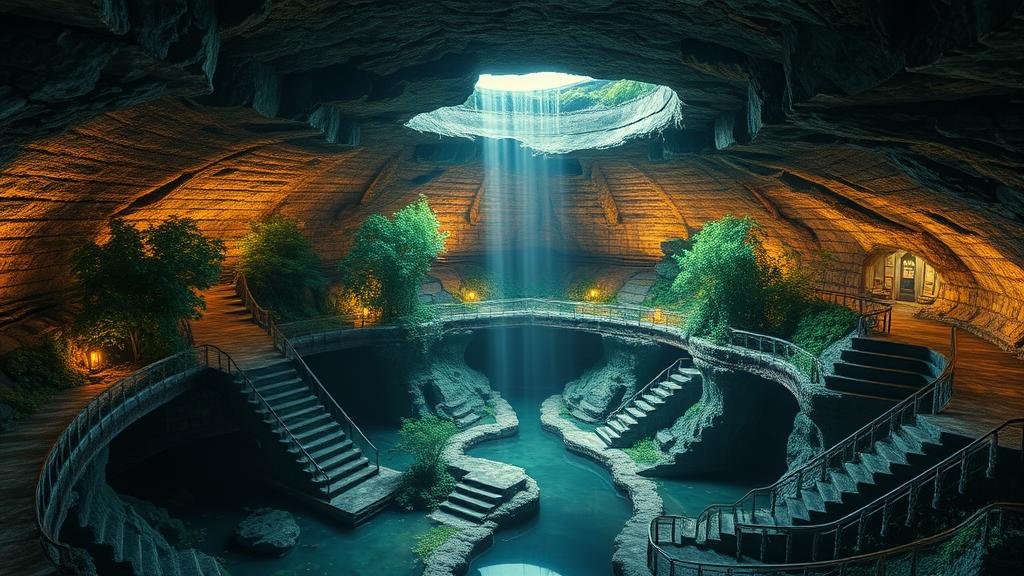Tracing the origins of the “Garden of Tranquility,†a mythical underground sanctuary.
Tracing the Origins of the “Garden of Tranquilityâ€
The “Garden of Tranquility†is a mythical underground sanctuary that has captivated the imagination of many cultures throughout history. This enchanting realm is often depicted as a serene escape from the chaos of the outside world, providing profound peace and rejuvenation to those fortunate enough to discover it. Tracing its origins reveals a rich tapestry of folklore, philosophy, and cultural beliefs that span across time and geography.
Historical Background
The concept of underground gardens is not entirely new and can be traced back to various ancient civilizations. For example, the Hanging Gardens of Babylon, considered one of the Seven Wonders of the Ancient World, were believed to be an elevated terraced garden that thrived in a desert-like climate. But, the specific notion of the “Garden of Tranquility†draws more directly from Eastern philosophies and the mystical traditions found in several cultures.
Connections to Eastern Philosophy
In many Eastern cultures, the idea of a hidden garden symbolizes enlightenment and inner peace. Traditional Chinese texts often reference mythical paradises that could be accessed through meditation and deep contemplation. For example, the Taoist concept of “Shangri-La,†which translates to an idealized place of peace and harmony, mirrors the essence of the Garden of Tranquility.
Also, the “Garden of Eden†from Judeo-Christian beliefs can also be seen as a precursor to the idea of an underground sanctuary where one can connect with the divine. Both gardens symbolize not just beauty, but also a return to purity and spiritual completeness.
Geographical Correlates
Quests for the Garden of Tranquility have led many explorers to various parts of the world, particularly in locations steeped in mystery. For example:
- The Himalayas: Many legends suggest that hidden valleys within these towering mountains hold an eternal garden where peace reigns supreme.
- The Amazon Rainforest: Some explorers have claimed that certain tribes speak of sacred groves deep within the jungle that lead to realms of inner tranquility.
These geographical correlates, intertwined with mythical narratives, have created a widespread belief in the existence of such sanctuaries around the globe.
Modern Interpretations
Today, the Garden of Tranquility resonates with various contemporary movements that emphasize mental health and well-being. In the hustle and bustle of modern life, people search for quietude and introspection, reflecting the fundamental appeal of this mythical space. Urban gardens and meditation retreats have emerged as modern equivalents, providing individuals with environments that nurture relaxation and holistic health.
Statistical trends support this shift; reports indicate that over 30% of adults in urban environments engage in meditation or mindfulness practices to cope with stress. The search for personal gardens–be they real or metaphorical–continues to gain traction.
Impact of Literature and Media
The depiction of the Garden of Tranquility in literature and media has further solidified its place in popular culture. Books such as “The Secret Garden†by Frances Hodgson Burnett and films like “Avatar†highlight the allure of nature as a healing space, fostering the idea that tranquility is rooted in our connection to the natural world.
The legacy of these stories contributes to a shared cultural understanding of the garden as a symbol for respite and rejuvenation. Such narratives invite audiences to consider their own “gardens,†literal or otherwise, where they can find solace.
Conclusion and Actionable Takeaways
The Garden of Tranquility, while a mythical sanctuary, reflects profound truths about human nature and our longing for peace. Understanding its origins and the various interpretations across cultures can help individuals seek their own forms of tranquility, both mentally and physically. To cultivate your personal Garden of Tranquility, consider the following actionable steps:
- Designate a quiet space in your home for meditation or relaxation.
- Engage with nature, whether through gardening, hiking, or simply spending time outdoors.
- Incorporate mindfulness practices into your daily routine to foster tranquility.
By recognizing and nurturing these elements in our lives, we can carve out our own sanctuaries, ensuring that the spirit of the Garden of Tranquility lives on, even in the modern world.



